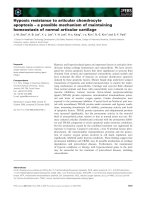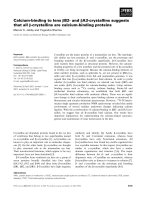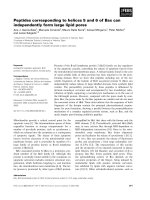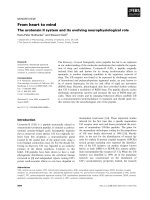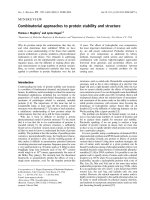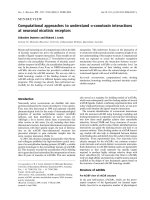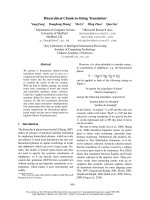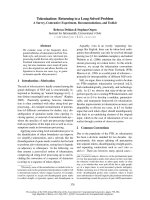Báo cáo khoa học: "DETERMINISTIC LEFT TO RIGHT PARSING OF TREE ADJOINING LANGUAGES*" ppt
Bạn đang xem bản rút gọn của tài liệu. Xem và tải ngay bản đầy đủ của tài liệu tại đây (398.13 KB, 8 trang )
DETERMINISTIC LEFT TO RIGHT PARSING OF
TREE ADJOINING LANGUAGES*
Yves Schabes
Dept. of Computer & Information Science
University of Pennsylvania
Philadelphia, PA 19104-6389, USA
K. Vijay-Shanker
Dept. of Computer & Information Science
University of Delaware
Newark, DE 19716, USA
Abstract
We define a set of deterministic bottom-up left to right
parsers which analyze a subset of Tree Adjoining Lan-
guages. The LR parsing strategy for Context Free
Grammars is extended to Tree Adjoining Grammars
(TAGs). We use a machine, called Bottom-up Embed-
tied Push Down Automaton (BEPDA), that recognizes
in a bottom-up fashion the set of Tree Adjoining Lan-
guages (and exactly this se0. Each parser consists of a
finite state control that drives the moves of a Bottom-up
Embedded Pushdown Automaton. The parsers handle
deterministically some context-sensitive Tree Adjoining
Languages.
In this paper, we informally describe the BEPDA then
given a parsing table, we explain the LR parsing algo-
rithm. We then show how to construct an LR(0) parsing
table (no lookahead). An example of a context-sensitive
language recognized deterministically is given. Then,
we explain informally the construction of SLR(1) pars-
ing tables for BEPDA. We conclude with a discussion
of our parsing method and current work.
1 Introduction
LR(k) parsers for Context Free Grammars (Knuth, 1965)
consist of a finite state control (constructed given a CFG)
that drives deterministically with k lookahead symbols
a push down stack, while scanning the input from left
to right. It has been shown that they recognize exactly
the set of languages recognized by deterministic push
down automata. LR(k) parsers for CFGs have been
proven useful for compilers as well as recently for nat-
ural language processing. For natural language process-
ing, although LR(k) parsers are not powerful enough,
*The first author is partially supported by Darpa grant N0014-85-
K0018, ARO grant DAAL03-89-C-003iPRI NSF grant-IRIS4-10413
A02. We are extremely grateful to Bernard Lang and David Weir for
their valuable
suggestions.
276
conflicts between multiple choices are solved by pseudo-
parallelism (Lang, 1974, Tomita, 1987). This gives rise
to a class of powerful yet efficient parsers for natural
languages. It is in this context that we study determin-
istic (LR(k)-style) parsing of TAGs.
The set of Tree Adjoining Languages is a strict su-
perset of the set of Context Free Languages (CFLs).
For example, the cross serial dependency constmction
in Dutch can be generated by a TAG. 1 Waiters (1970),
R~v6sz (1971), Turnbull and Lee (1979) investigated
deterministic parsing of the class of context-sensitive
languages. However they used Turing machines which
recognize languages much more powerful than Tree Ad-
joining Languages. So far no deterministic bottom-up
parser has been proposed for any member of the class
of the so-called "mildly context sensitive" formalisms
(Joshi, 1985) in which Tree Adjoining Grammars fall. 2
Since the set of Tree Adjoining Languages (TALs) is a
strict superset of the set of Context Free Languages, in
order to define LR-type parsers for TAGs, we need to
use a more powerful configuration then a finite state au-
tomaton driving a push down stack. We investigate the
design of deterministic left to right bottom up parsers for
TAGs in which a finite state control drives the moves
of a Bottom-up Embedded Push Down Stack. The class
of corresponding non-deterministic automata recognizes
exactly the set of TALs.
We focus our attention on showing how a bottom-
up embedded pushdown automaton is deterministically
driven given a parsing table. To illustrate the building
of a parsing table, we consider the simplest case, i.e.
building of LR(0) items and the corresponding LR(0)
1The parsers that we develop in this paper can parse these con-
structions deterministically (see Figure 5).
2Tree Adjoining Grammars, Modified Head Grammars, Linear In-
dexed Grammars and Categorial Grammars (all of which generate
the same subclass of context-sensitive languages) fall in the class of
the so-called "mildly context sensitive" formalisms. The Embedded
Push Down Automaton recognizes exactly this set of languages (Vijay-
Shanker 1987).
parsing table for a given TAG. An example for a TAG
generating a context-sensitive language is given in Fig-
ure 5. Finally, we consider the construction of SLR(1)
parsing tables.
We assume that the reader is familiar with TAGs. We
refer the reader to Joshi (1987) for an introduction to
TAGs. We will assume that the trees can be combined
by adjunction only.
2 Automata Models of Tags
Before we discuss the Bottom-up Embedded Push-
down Automaton (BEPDA) which we use in our parser,
we will introduce the Embedded Pushdown Automaton
(EPDA). An EPDA is similar to a pushdown automaton
(PDA) except that the storage of an EPDA is a sequence
of pushdown stores. A move of an EPDA (see Figure 1)
allows for the introduction of bounded pushdowns above
and below the current top pushdown. Informally, this
move can be thought of as corresponding to the adjoin-
ing operation move in TAGs with the pushdowns intro-
duced above and below the current pushdown reflecting
the tree structure to the left and right of the foot node of
an auxiliary being adjoined. The spine (path from root
to foot node) is left on the previous stack.
The generalization of a PDA to an EPDA whose stor-
age is a sequence of pushdowns captures the generaliza-
tion of the nature of the derived trees of a CFG to the
nature of derived trees of a TAG. From Thatcher (1971),
we can observe that the path set of a CFG (i.e. the set
of all paths from root to leaves in trees derived by a
CFG) is a regular set. On the other hand, the path set
of a TAG is a CFL. This follows from the nature of the
adjoining operation of TAGs, which suggests stacking
along the path from root to a leaf. For example, as we
traverse down a path in a tree 3' (in Figure 1), if ad-
junction, say by/~, occurs then the spine of/~ has to be
traversed before we can resume the path in 7.
~
e
~
-gQeft of foot d [~
~ .,~splne of I~
i~fight d foot of ~
Figure 1: Embedded Pushdown Automaton
277
3 Bottom-up Embedded Push-
down Automaton 3
For any TAG G, an EPDA can be designed such that
its moves correspond to a top-down parse of a string
generated by G (EPDA characterizes exactly the set of
Tree Adjoining Languages, Vijay- Shanker, 1987). If
we wish to design a bottom-up parser, say by adopting
a shift reduce parsing strategy, we have to consider the
nature of a reduce move of such a parser (i.e. using
EPDA storage). This reduce move, for example applied
after completely considering an auxiliary tree, must be
allowed to 'remove' some bounded pushdowns above
and below some (not necessarily bounded) pushdown.
Thus (see Figure 2), the reduce move is like the dual of
the wrapping move performed by an EPDA.
Therefore, we introduce Bottom-up Embedded Push-
down Automaton (BEPDA), whose moves are dual of
an EPDA. The two moves of a BEPDA are the unwrap
move depicted in Figure 2 - which is an inverse of
the wrap move of an EPDA - and the introduction of
new pnshdowns on top of the previous pushdown (push
move). In an EPDA, when the top pnshdown is emp-
tied, the next pushdown automatically becomes the new
top pushdown. The inverse of this step is to allow for
the introduction of new pushdowns above the previous
top pushdown. These are the two moves allowed in a
BEPDA, the various steps in our parsers are sequences
of one or more such moves.
Due to space constraints, we do not show the equiva-
lence between BEPDA and EPDA apart from noting that
the moves of the two machines are dual of each other.
4 LR Parsing Algorithm
An LR parser consists of an input, an output, a sequence
of stacks, a driver program, and a parsing table that has
three parts (ACTION, GOTOright and
GOTO.foot).
The
parsing program is the same for all LR parsers, only
the parsing tables change from one grammar to another.
The parsing program reads characters from the input one
character at a time. The program uses the sequence of
stacks to store states.
The parsing table consists of three parts, a pars-
ing action function ACTION and two goto functions
GOTOright and GOTOloot. The program driving the
LR parser first determines the state i currently on top
of the top stack and the current input token
at.
Then it
consults the ACTION table entry for state i and token
3The need to use bottom-up version of an EPDA in LR style pars-
ing of TAGs was suggested to us by Bernard Lang and David Weir.
Also their susgestions played all
insU~llaK~[
v01e in the definition of
BBPDA, for example restriction on the moves allowed.
read only input tape
u
stack of aac~
BEPDA
Bounded number [1
of stacks II
of bounded size
1
Bounded number [~
of stack elements
Unbounded number (1
of stack elements ~.J
Bounded number
of stacks II
of bounded size ~,1
A~
All
al
BI
7"
Bn
EPDA
lnove
UNWRAP move
[]
PUSH move
Figure 2: Bottom-up Embedded Pushdown Automaton
at. The entry in the action table can have one of the
following five values:
• Shift j (s j), where j is a state;
• Resume Right of 6 at address dot (rs6@dot)),
where 6 is an elementary tree and dot is the ad-
dress of a node in 6;
•
Reduce Root
of the auxiliary tree/5 in which the
last adjunction on the spine was performed at ad-
dress star (rd/3@star);
• Accept (acc);
• Error, no action applies, the parsers rejects the in-
put string (errors are associated with empty table
entries).
The function
GOTOright
and GOTOfoo, take a state
i and an auxiliary tree # and produce a state j.
An example of a parsing table for a grammar gener-
ating L = {anbnecndnln > 0} is given in Figure 5.
We denote an instantaneous description of the
BEPDA by a pair whose first component is the sequence
of pushdowns and whose second component is the un-
expanded input:
(lltm'' "till" "-Ilsl"
"sw,
a~a~+l a,$)
In the above sequence of pushdowns, the stacks are
piled up from left to right.
II
stands for the bottom of a
stack, s~ is the top element of the top stack, Sx is the
bottom element of the top stack, tl is the top element
of the bottom stack and tm is the bottom element of the
bottom stack.
The initial configuration of the parser is set
to:
(110, al an$)
where 0 is the start state and ax • a,$ is the input string
to be read with an end marker ($).
278
Suppose the parser reaches the configuration:
(lit,,,"
"till" "IIi~"""
ill, arar+l , an$)
The next move of the parser is determined by reading
at, the current input token and the state i on top of the
sequence of stacks, and then consulting the parsing table
entry for ACTION[i, a,]. The parser keeps applying the
move associated with ACTION[i, at] until acceptance or
error occurs. The following moves are possible:
(i)
(ii)
ACTION[/, at] = shift state j (,j). The parser exe-
cutes a push move, entering the configuration:
(lltm''' tx II"" IIi~o • • •
ilillJ,
at+l"'" an$)
ACTION[/, at] = resume right of 6 at address dot
(rs6@doO. The parser is coming to the right and
below of the node at address dot in 6, say ri, on which
an auxiliary tree has been adjoined. The information
identifying the auxiliary tree is in the sequence of
stacks and must be recovered. There are two eases:
Case 1:71 does not subsume a foot node. Let k
be the number of terminal symbols subsumed by r/.
Before applying this move, the current configuration
looks like:
(ll"" Ilikll "" IIi111i,
a, "an$)
The k top first stacks are merged into one stack
and the stack
IIm is pushed on top of
it, where
m = GOTOfoo,[ik, #] for some auxiliary tree # that
can be adjoined in 6 at 71, and the parser enters the
configuration:
(11""" Ilikllit-t "'"
ix illm, at"" a,$)
Case 2:~7 subsumes the foot node of 6. Let k (resp.
k') be the number of terminal symbols to the right
(resp. to the left) of the foot node subsumed by r/.
Before applying this move, the configuration looks
like:
(ll" "" Ilnv+tll""" Ilnxllsl" "" szllik" "" Iii111i, a, a.$)
The k' stacks below the k + 2 *h stack from the top
as well as the k + 1 top stacks are rewritten onto the
k + 2 th stack and the stack
lira
is pushed on top of it,
where m = GOTO/oot[nk,+ x,/3] for some auxiliary
tree ~ that can be adjoined in 6 at ,7, and the parser
enters the configuration:
(11"" Ilnv+lllsl ""
.sink
nlik , ixil]m, a~ an$)
(iii) ACTION[/, at] = reduce root of an auxiliary tree/3
in which the last adjunction on the spine was per-
formed at address
star (rdfl@star). The
parser has
finished the recognition of the auxiliary tree/L It
must remove all information about/3 and continue
the recognition of the tree in which/3 was adjoined.
The parser executes an unwrap move. Let k (resp.
k') be the number of terminal symbols to the left
(resp. to the righO of the foot node of B. Let ff be
the node at address
star
in/3 (ff =
nil
if
star is not
set). Let p be the number of terminal symbols to
the left of the foot node subsumed by ~ (p = 0 if
= nil).
p + k' + 1 symbols from the top of the
sequence of stacks popped. Then k - p single ele-
ment stacks below the new top stack are unwrapped.
Let j be the new top element of the top stack. Let
ra = GOTOriaht~, t~]. j
is popped and the
single
element stack
lira is pushed on top of the top
stack.
By keeping track of the auxiliary trees being reduced,
it is possible to output a parse instead of acceptance or
an error.
The parser recognizes the derived tree inside out: it
extracts recursively the innermost auxiliary tree that has
no adjunction performed in it.
5 LR(0) Parsing Tables
This section explain how to construct an LR(0) parsing
table given a TAG. The construction is an extension
of the one used for CFGs. Similarly to Schabes and
Joshi (1988), we extend the notion of dotted rules to
trees. We define the closure operations that correspond
to adjunction. Then we explain how transitions between
states are defined. We give in Figure 5 an example of
a finite state automaton used to build the parsing table
for a TAG (see Figure 5) generating a context-sensitive
language.
We first explain preliminary concepts (originally de-
fined to construct an Earley-type parser for TAGs) that
will be used by the algorithm. Dotted rules are extended
to trees. Then we recall a tree traversal that the algo-
rithm will mimic in order to scan the input from left to
right.
A dotted symbol is defined as a symbol associated
with a dot
above or below
and either
to the left
or
to
279
the right
of it. The four positions of the dot are anno-
tated by
ia, ib,
ra, rb (resp. left above, left below, right
above, right below): taa,~ In practice, only two dot
Ib.L.rb •
positions can be used (to the left and to the fight of
a node). However, for sake of simplicity, we will use
four different dot positions. A dotted tree is defined
as a tree with exactly one dotted symbol. Furthermore,
some nodes in the dotted tree can be marked with a star.
A star on a node expresses the fact that an adjunction
has been performed on the corresponding node. A dot-
ted tree is referred
as [c~, dot, pos, stars],
where o~ is a
tree, dot is the address of the dot,
pos is the
position of
the dot
(la, lb, ra
or
rb) and stars
is a list of nodes in
a annotated by a star.
Given a dotted tree with the dot above and to the left
of the root, we define a tree traversal of a dotted tree (as
shown in the Figure 3) that will enable us to scan the
frontier of an elementary tree from left to right while try-
ing to recognize possible adjunctions between the above
and below positions of the dot of interior nodes.
STAa :
.ao
•
E F G H I
2.1 2.2 2.3 3.1 3.2
Figure 3: Left to Right Tree Traversal
A state in the finite state automaton is defined to be
a set of dotted trees closed under the following opera-
tions: Adjunction Prediction, Left Completion, Move
Dot Down, Move Dot Up and Skip Node (See Fig-
tire 4). 4
Adjunction Prediction predicts all possible auxiliary
trees that can be adjoining at a given node. Left Com-
pletion occurs when an auxiliary tree is recognized up
to its foot node. All trees in which that tree can be
adjoined are pulled back with the node on which ad-
junction has been performed added to the list of stars.
Move Dot Down moves the dot down the links. Move
Dot Up moves the dot up the links. Skip Node moves
the dot up on the right hand side of a node on which no
adjunction has been performed.
All the states in the finite state automaton (FSA) must
be closed under the closure operations. The FSA is
4These operations correspond to proeesson in the Eadey-type
parser for TAGs.
/%
/%
"A
Adjunction Prediction
Move Dot Up
Move Dot Down
A
Left Completion
stap node
Figure 4: Closure Operations
build as follows. In states set 0, we put all initial trees
with a dot to the left and above the root. The state is
then closed. Then recursively we build new states with
the following transitions (we refer to Figure 5 for an
example of such a construction).
• A transition on a (where a is a terminal symbol)
from
Si to Sj
occurs if and only if in Si there is a
dotted
tree [6, dot, la, stars] in
which the dot is to
the left and above a terminal symbol a; Sj consists
of the closure of the set of dotted trees of the form
[6, dot, ra, stars].
• A transition on/3~ight from
Si to Sj
occurs iff in
Si there is a dotted
tree [8, dot, rb, stars]
such that
the dot is to the right and below a node on which
/3 can he adjoined;
Sj
consists of the closure of the
set of dotted trees of the form
[8, dot, ra, stars'].
If the dotted node of
[8, dot, rb, stars]
is not on the
spine 5 of 8,
star'
consists of all the nodes in
star
that strictly dominate the dotted node. When the
dotted node is on the spine,
stars'
consists of all
the nodes in
star
that strictly dominate the dotted
node, ff there are some, otherwise
stars' = {dot}.
• A Skip foot of
[/3, dot, lb, stars]
transition from
Si to Sj occurs iff in S~ there is a dotted tree
[/3, dot, lb, stars]
such that the dot is to the left
and below the foot node of the auxiliary tree/3; Sj
consists of the closure of the set of dotted trees of
the form
[/3, dot, rb, stars].
The parsing table is constructed from the FSA built as
above. In the following, we write
trans(i, z)
for set of
states in the FSA reached from state i on the transition
labeled by z.
The actions for
ACTION(i, a)
are:
• Shift
j (sc(j)).
It applies fff
j E trans(i, a).
5Nodes on the path from root node to foot node. 280
• Resume Right of /6,
dot, rb, stars] (rsS@dot).
It applies iff in state i there is a dotted tree
[8, dot, rb, stars],
where
dot E stars.
• Reduce Root of/3
(rd/3@star).
It applies iff in
state i there is a dotted tree
[/3, O, ra, {star}],
where
/3 is an auxiliary tree. 6
• Accept occurs iff a is the end marker (a = $) and
there is a dotted
tree [~, O, ra, {star}],
where a is
an initial tree and the dot is to the right and above
the root node.
• Error, if none of the above applies.
The GOTO table encodes the transitions in the
FSA on non-terminal symbols. It is indexed by
a state and by
/3right
or /31oot, for all auxiliary
trees /3: j G GOTO(i, label)
iff there is a tran-
sition from i to j on the given label
(label E
{/3riaht,/3/oot
I/3 is an auxiliary tree}.
If more than one action is possible in an entry of the ac-
tion table, the grammar is not LR(0): there is a conflict
of action, the grammar cannot be parsed deterministi-
tally without lookahead.
An example of a finite state automaton used for the
construction of the LR(0) table for a TAG (trees cq,/31
in Figure 5) generating 7 L =
{anbneendnln >_
O}, its
corresponding parsing table is given and an example of
sequences of moves are given in Figure 5.
60
is
the address of the root node.
tin the given TAG (trees ~1 and/31), if we omit a and c,
we
obtain
a TAG that is similar to the one for the Dutch cross-serial construction.
This grammar can still bc handled by an LR(0) parser.
In the trees c~ and /3, na stand for null adjuncfion constraint (i.e.
no anxifiary tree can be adjoined on a node with null adjunction
constraint).
TAG for L = {a"b~ec"d "}
Sea
A',,
a Sd
(~) //~
b S~a e
a S d
b S~
"~
• bS.o
• ,' S d
b S~
s
(~)l
e
'~ S~d -~ b S d
a'$ d It a •
/t,, /1",, /r',, b'Sc
b Snac b Suc b Sna¢
I
a/~d "a S d a.~ • Sd .,.S*d
/~ ./~ [b -S~ c
b Suc b Suc b S~,a¢ b S~a¢
"Ae Ae, Ae
• S* d a S*d • S* d
aSd aSd
b S~c b.Snac
a S* d e *e
./1~
bSc
aSd
bS, c
I0 I' ~ ~ 7
o/rN. "bS~
b S c b Sine
8
1~ '~*C~ ~ 12( Jl~u ~3 (~°~v b ~*~ :~t I~
]a S d a S*~l[~ dl a S*d " S ¢
b F I Z n,¢',
cT
a S*d
/'I',,,
bS¢
b Snac b S~a~)
[ PARSING ACTION
II
GOTO
I
II fcot [[ right
Finite State Aatomaton for a BEPDA Recognizing L = { a " b " ecn d" }
a b c d e $ /5' /3
Parser configuration Next move
(llo,
aabbeccdd$)
(lloll2,
abbeccdd$)
<110112112,
bbeccdd$)
(110112112113,
b~ccdd$)
(110112112113119,
eccdd$)
(110112112ll3ll9ll4,
ccdd$)
(I]0112112[[3[[9[[4[[10,
ccdd$)
(110112112[[3[[9114[[101111,
cdd$)
(110112112113114 9 10 11116,
cdd$)
(110112112113114 9 10 11116117,
dd$)
(110H2H2H3H4 9 10 11[[6117[[8, d$)
(110[[2ll4 9 101112, d$)
(lloll2114
9
lO1[121113,
$)
<110[15, *)
s2
s2
s3
s9
s4
rsa@O
sll
rs~@2
s7
s8
rd~@ -
s13
rd/3~2
ace
Example of LR(O) Parsing Table
Example of sequences of moves
sj _ Shift j;
rs6~dot
Resume Right of 6 at
dot; rd~star
Reduce Root of/~ with star at address
star; $
end of input.
Figure 5: Example of the construction of an LR(0) parser for a TAG recognizing
L = {a'~bnec"d" }
281
6 SLR(1) Parsing Tables
The tables that we have constructed are LR(0) tables.
The Resume Right and Reduce Root moves are per-
formed regardless of the next input token. The accu-
racy of the parsing table can be improved by comput-
ing lookaheads. FIRST and FOLLOW can be extended
to dotted trees, s FIRST of a dotted tree corresponds to
the set of left most symbols appearing below the subtree
dominated by the dotted node. FOLLOW of a dotted tree
defines the set of tokens that can appear in a derivation
immediately following the dotted node. Once FIRST
and FOLLOW computed, the LR(0) parsing table can
be improved to an SLR(1) table: Resume Right and Re-
duce Root are applicable only on the input tokens in the
follow set of the dotted tree.
For example, the SLR(1) table for the TAG built with
trees oq and ~1 is given in Figure 6.
I PARSING AC'TION
II
GOTO[
I
I1 foot II right I
I I'lbl 'c I a lel S
I1~11 ~1
6
Figure 6: Example of SLR(1) Parsing Table
By associating dotted trees with lookaheads, one can
also compute LR(k) items in the finite state automaton
in order to build LR(k) parsing tables.
7 Current Research
The deterministic parsers we have developed do not sat-
isfy an important property satisfied by LR parsers for
CFG. This property is often described as the viable pre-
fix property which states that as long as the portion of
the input considered so far leads to some stack configu-
ration (i.e. does not lead to error), it is always possible
to find a suffix to obtain a string in the language.
Our parsers do not satisfy this property because the
left completion move is not a 'reduce" move. This move
aDue to the lack of space, we do not define FIRST and FOLLOW.
How¢ver, we explain the basic principles used for the computafi~m of
FIRST and FOLI£)W. 282
applies when we have reached a bottom-left end (to the
left of the foot node) of an auxiliary tree, say/3. If we
had considered this move to be a reduce move, then by
popping appropriate amount of elements off the storage
would allow us to figure out which tree (into which/3
was adjoined), say a, to proceed with. Rather than us-
ing this information (that is available in the storage of
the BEPDA), by putting left completion in the closure
operations, we apply a move that is akin to the predict
move of Earley parser. That is we continue by consider-
ing every possible nodes/3 could have been adjoined at,
which could include nodes in trees that were not used
so far. However, we do not accept incorrect strings, we
only lose the prefix property (for an example see Fig-
ure 7). As a consequence, errors are always detected but
not as soon as possible.
Parser configuration Next move
([10, aabeccdd$)
¢11o112,
abeccdd$)
(liO[[2U2, beccdd$)
(llo112ll2113,
,c,dd$)
(Iio1[21121131[4, ccdd$)
(11o1121121131141[6, ccdd$)
(11o112112113114116117, ~dd*)
s2
s2
s3
s4
rsa@O
s7
¢ITOr
Figure 7: Example of error detecting
The reason why we did not consider the left comple-
tion move to be a reduce move is related to the restric-
tions on moves of BEPDA which is weakly equivalent
to TAGs (perhaps also due to the fact that left to right
parsing may not be most natural for parsing TAGs which
produce trees with context-free path sets). In CFGs,
where there is only horizontal stacking, a single reduc-
tion step is used to account for the application of rule
in left to right parsing. On the other hand, with TAGs,
if a tree is used successfully, it appears that a prediction
move and more than one reduction move are necessary
for auxiliary tree. In left to right parsing, a prediction is
made to start an auxiliary tree/3 at top left end; a reduc-
tion is appropriate to recover the node/3 was adjoined at
the left completion stage; a reduction is needed again at
resume right state to resume the right end of t; finally a
reduction is needed at the right completion stage. In our
algorithm, reductions are used at right resume stage and
reduce right state. Even if a reduction step is applied at
left completion stage, an encoding of the fact that left
part of/3 (as well as the left part of trees adjoined on
the spine of/~) has been completed has to be restored in
the storage (note in a reduction move of any shift reduce
parser for CFGs, any information about the rule used is
discarded once reduction step applied). So far we have
not been able to apply a reduction step at the left com-
pletion stage, reinsert the left part of fl and yet maintain
the correct sequence in the storage so that the right part
of/3 can be recovered at the resume right stage. We are
considering alternative strategies for shift reduce parsing
with BEPDA as well as considering whether there are
other automata models equivalent to TAGs better suited
for deterministic left to right parsing of tree-adjoining
languages.
Conclusion
We have introduced a bottom-up machine (Bottom-up
Embedded Push Down Automaton) that enabled us to
define LR-like parsers for TAGs. The machine recog-
nizes in a bottom-up fashion exactly the set of Tree Ad-
joining Languages.
We described the LR parsing algorithm and a method
for computing LR(0) parsing tables. We also men-
tioned the possibility of building SLR(k) parsing tables
by defining the notions of FIRST and FOLLOW sets for
TAGs.
As shown for the example, no lookaheads are nee-
essary to parse deterministically the language L =
{anbnec"d"ln >_ O}. If instead of using e, we had the
empty string e in the initial tree, LR(0)-like parser will
not be enough. On the other hand SLR(1)-like parser
will suffice.
We have noted that our parsers do not satisfy the valid
prefix property. As a consequence, errors are always
detected but not as soon as possible.
Similar to the work of Lang (1974) and Tomita (1987)
extending LR parsers for arbitrary CFGs, the LR parsers
for TAGs can be extended to solve by pseudo-parallelism
the conflicts of moves.
Lang, Bernard, 1974. Deterministic Techniques for EffÉ-
cient Non-Deterministic Parsers. In Loeckx, Jacques
(editor), Automata, Languages and Programming,
2rid Colloquium, University of Saarbri~cken. Lecture
Notes in Computer Science, Springer Verlag.
R6v6sz, G., 1971. Unilateral context sensitive gram-
mars and left to fight parsing. J. Comput. System Sci.
5:337-352.
Schabes, Yves and Joshi, Aravind K., June 1988. An
Earley-Type Parsing Algorithm for Tree Adjoining
Grammars. In 26 th Meeting of the Association for
Computational Linguistics (A CL' 88 ). Buffalo.
Thatcher, J. W., 1971. Characterizing Derivations Trees
of Context Free Grammars through a Generalization
of Finite Automata Theory. J. Comput. Syst. Sci.
5:365-396.
Tomita, Masaru, 1987. An Efficient Augmented-
Context-Free Parsing Algorithm. Computational Lin-
guistics 13:31 46.
Turnbull, C. J. M. and Lee, E. S., 1979. Generalized
Deterministic Left to Right Parsing. Acta lnformatica
12:187-207.
Vijay-Shanker, K., 1987. A Study of Tree Adjoining
Grammars. Phi) thesis, Department of Computer and
Information Science, University of Pennsylvania.
Waiters, D.A., 1970. Deterministic Context-Sensitive
Languages. Inf. Control 17:14 40.
References
Joshi, Aravind IC, 1985. How Much Context-
Sensitivity is Necessary for Characterizing Struc-
tural Descriptions Tree Adjoining Grammars. In
Dowry, D., Karttunen, L., and Zwicky, A. (editors),
Natural Language Processing Theoretical, Compu-
tational and Psychological Perspectives. Cambridge
University Press, New York. Originally presented in
a Workshop on Natural Language Parsing at Ohio
State University, Columbus, Ohio, May 1983.
Joshi, Aravind K., 1987. An Inmxluction to Tree Ad-
joining Grammars. In Manaster-Ramer, A. (editor),
Mathematics of Language. John Benjamins, Amster-
dam.
Knuth, D. E., 1965. On the translation of languages
from left to
right.
Inf.
Control 8:607-639. 283
